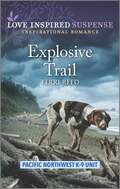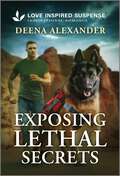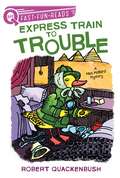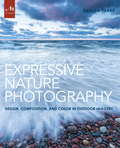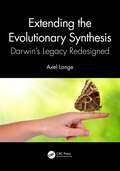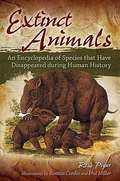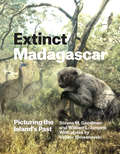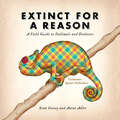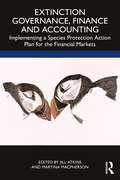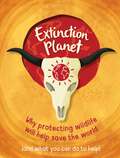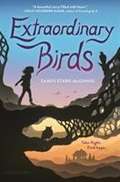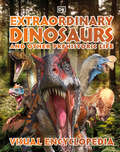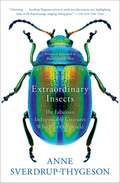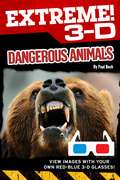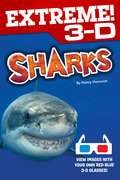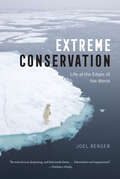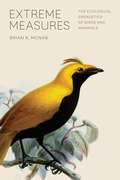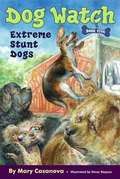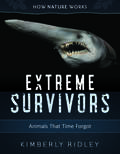- Table View
- List View
Explosive Trail (Pacific Northwest K-9 Unit #3)
by Terri ReedCan an officer and her K-9 partner survive a bomber with a vendetta? When a serial bomber&’s explosion in Olympic National Park lands K-9 officer Willow Bates in the hospital, her estranged husband, FBI agent Theo Bates, rushes to her side. He&’s determined to protect her and the baby he didn&’t know she was carrying. But the bomber has revenge on his mind and will stop at nothing to finish them off.From Love Inspired Suspense: Courage. Danger. Faith.Pacific Northwest K-9 Unit Book 1: Shielding the Baby by Laura ScottBook 2: Scent of Truth by Valerie HansenBook 3: Explosive Trail by Terri ReedBook 4: Olympic Mountain Pursuit by Jodie BaileyBook 5: Threat Detection by Sharon DunnBook 6: Cold Case Revenge by Jessica R. PatchBook 7: Undercover Operation by Maggie K. BlackBook 8: Snowbound Escape by Dana Mentink
Exposing Lethal Secrets
by Deena AlexanderThis bodyguard and his K-9 will do anything to uncover the truth. Stumbling upon a burning car and rescuing an injured woman wasn&’t on bodyguard Caleb Miller&’s vacation itinerary—nor were the gunmen who open fire on them. But Olivia Delaney has no memory of who she is or how she got there, only that she is under threat. Vowing to protect the woman in danger, Caleb and his K-9 go on the run with Olivia. As they work to stay a step ahead of her pursuers, they must untangle her past together…before her family&’s deadly schemes bury them both.From Love Inspired Suspense: Courage. Danger. Faith.
Express Train to Trouble: A Miss Mallard Mystery (QUIX)
by Robert QuackenbushWorld-famous duck-tective Miss Mallard works to solve the case of a missing prankster in this engaging Aladdin QUIX mystery.Miss Mallard sets out to explain the disappearance of George Buddy Duck, a prankster who has aggravated all of the passengers on a train. Will she find him before he has the chance to cause more mayhem?
Expressive Nature Photography: Design, Composition, and Color in Outdoor Imagery
by Brenda TharpPhotographer and teacher Brenda Tharp marries photography craft with artistic vision to help intermediate photographers translate what they see into a personal impression of a subject in nature. Using single images, along with before-and-after and with-or-without examples, Expressive Nature Photography teaches how to make exposures that are creative, not necessarily correct. Inspiring photographers to get out early and stay out late, this book explains how to use light, an essential element of outdoor photography. Readers will learn how to “see in the dark,” use filters to create very long exposures, create a natural effect using light painting, photograph night skies and moonlit landscapes, and make the best use of available natural light. This book also covers how to use shutter speeds to express motion and capture the energy of fast-moving subjects, such rushing streams, ocean swells, and bounding wildlife. A chapter on the art of visual flow discusses how to create compositions that direct the viewer's eye through the frame for maximum impact. Photographers will develop a sense of when to break the "rules" of composition, how to use elements to frame subjects, what to include and exclude in the frame, how to create the feeling of depth and dimension in a scene, and how to push the boundaries of composition to make memorable nature images that capture and convey fresh viewpoints. High-tech cameras can help create a good exposure and focused image, but they can't replace the artist's eye for composition, visual depth, and design, nor their instinct for knowing when to click the shutter. There are many books on photography technique focused on technical quality, but Expressive Nature Photography goes beyond the technical. It guides the way to pulling emotion and meaning out of a dynamic landscape, a delicate macro study, or an outstanding nighttime image.
Extending the Evolutionary Synthesis: Darwin’s Legacy Redesigned
by Axel LangeThe theory of evolution is itself evolving with new findings and changes in the fundamental underlying concepts. It is true that today's synthetic theory, which goes back to Darwin, is persistently successful. However, it offers no convincing explanation to many questions, some examples of which are as follows: What forms of inheritance exist besides genetics; how complex variations, especially evolutionary innovations such as bird feathers and turtle shells, arise; how the environment affects the evolution of species and is changed by them simultaneously; and why the evolution of birds, corals, and human culture is not explainable by natural selection alone. Scientific findings of the last decades require continuous rethinking and integration of new data and concepts into the theory of evolution. This comprehensibly written and excellently researched book provides exciting new insights into the Extended Evolutionary Synthesis using fascinating new examples from evolutionary biology. Key Features Comprehensively explains the Extended Evolutionary Synthesis Understandably written for a broad audience Includes interviews with world-leading evolutionary biologists Reviews the historical development of evolutionary theory with explanations of open, unanswered questions Explains the new concepts with powerful illustrations Related Titles Bard, J. Evolution: The Origins and Mechanisms of Diversity (ISBN 9781032138480) Johnson, N. Darwin’s Reach: 21st Century Applications of Evolutionary Biology (ISBN 9781138587427)
Exterminator (Thoroughbred Legends #18)
by Eva Jolene BoydEven in the time of great horses like Man o' War, Colonel Matt J. Winn, the father of the Kentucky Derby, called Exterminator "the greatest all-around Thoroughbred in American racing history." "Old Bones" as he was called, ran from 1917-1924 and even won the 1918 Kentucky Derby. Gelded as a two-year-old, Exterminator was purchased as a work mate for Willis Sharpe Kilmer's Kentucky Derby hopeful, Sun Briar. However, Sun Briar never made it to the Derby, and Exterminator went in his place. The rest, as they say, is history. Exterminator went on to race 100 times, finishing in the money 84 times. He died in his stall in 1945 and was inducted into the Racing Hall of Fame in 1957.
Extinct Animals: An Encyclopedia of Species That Have Disappeared During Human History
by Ross PiperA British scholar of natural history, Piper profiles extinct animals within in chronological sections, first during the past century, then two, then five. He pushes the boundary of what can strictly be called history with the next section, to 10,000 years ago, then progresses ever further back to more than 50,000 years ago. The pivotal section focuses on the relatively short period 10,000 to 12,500 years ago, when many believe a mass extinction period began that will eventually be larger than any in the archaeological record. He downplays the Great Human Hunter model of extinction, mentioning climate change, habitat destruction, and other factors as well as predation from humans and others. Photographs are provided of live or preserved individuals for some recent species, but most are illustrated with drawings by Renata Cunha and Phil Miller, along with a few photographs of displayed skeletons. Annotation ©2009 Book News, Inc., Portland, OR (booknews.com)
Extinct Madagascar: Picturing the Island's Past
by Steven M. Goodman William L. Jungers Velizar SimeonovskiThe landscapes of Madagascar have long delighted zoologists, who have discovered, in and among the island’s baobab trees and thickets, a dizzying array of animals, including something approaching one hundred species of lemur. Madagascar’s mammal fauna, for example, is far more diverse, and more endemic, than early explorers and naturalists ever dreamed of. But in the past 2,500 or so years—a period associated with natural climatic shifts and ecological change, as well as partially coinciding with the arrival of the island’s first human settlers—a considerable proportion of Madagascar’s forests have disappeared; and in the wake of this loss, a number of species unique to Madagascar have vanished forever into extinction. In Extinct Madagascar, noted scientists Steven M. Goodman and William L. Jungers explore the recent past of these land animal extinctions. Beginning with an introduction to the geologic and ecological history of Madagascar that provides context for the evolution, diversification, and, in some cases, rapid decline of the Malagasy fauna, Goodman and Jungers then seek to recapture these extinct mammals in their environs. Aided in their quest by artist Velizar Simeonovski’s beautiful and haunting digital paintings—images of both individual species and ecosystem assemblages reproduced here in full color—Goodman and Jungers reconstruct the lives of these lost animals and trace their relationships to those still living. Published in conjunction with an exhibition of Simeonovski’s artwork set to open at the Field Museum, Chicago, in the fall of 2014, Goodman and Jungers’s awe-inspiring book will serve not only as a sobering reminder of the very real threat of extinction, but also as a stunning tribute to Madagascar’s biodiversity and a catalyst for further research and conservation.
Extinct for a Reason
by Aaron Adler Scott CooneyBefore there was Darwin, before there was man's best friend, there were . . . Failimals. The Royal Failimal Society presents the Unchameleon, Bipolar Bear, Emo Emu, and other Darwin-defiant animals that, though fascinating, have clearly become extinct for a reason. The culmination of years of research, study, and observation across each continent and every era, Extinct for a Reason is the definitive field guide to the hows, whys, and whats of Failimals and Evolosers. With colorful illustrations and vital information on everything from mating habits to defense mechanisms, this book is a must-have for any species considering undergoing the evolutionary process. Learn how to avoid common mistakes, such as: Alienating oneself from one's peers (see: Goth Sloth) Refusing to admit one's genes are improperly sized (see: Muffintopotamus) Having dangerously high levels of charisma (see: Elvisaurus) Weeded out but still proud, the curious creatures collected within serve as a warning to ambitious animals everywhere: Evolve with Caution.
Extinction Governance, Finance and Accounting: Implementing a Species Protection Action Plan for the Financial Markets
by Jill AtkinsThe planet is currently experiencing a mass extinction event, with human and business activity being the root cause of species loss and habitat destruction. Industries, companies, banks, investors, accountants and auditors have all played their role. This book explores how they can also provide a solution. The book presents plans, metrics, frameworks, mechanisms and financial innovations that can be, and are being, implemented through the financial markets in order to save and protect species, enhance biodiversity and, at the same time, preserve the financial markets and the business world. This biodiversity handbook addresses the intersection between species extinction and the global capitalist system. With contributions from leading non-governmental organisations such as the Capitals Coalition, Business for Nature, the Ecojustice Foundation, ShareAction and the Endangered Wildlife Trust, plus senior researchers in the field, as well as industry experts from Moody’s, EOS at Hermes Federated Investment Management, BlueBay Asset Management, ODDO BHF Asset Management and OSSIAM (to mention just a few), this book is at the forefront of addressing the crucially important topics of extinction accounting, finance and governance. Drawing on leading research, the book is written in an accessible style and is relevant to researchers and students in the fields of sustainability, governance, accounting, finance, corporate social responsibility and corporate governance. It is essential reading for investors, responsible investors, bankers, business leaders and policy makers in the field of sustainable financial markets. Given the interdisciplinary nature of this book, it is useful to conservationists, ecologists and others involved in species and biodiversity protection.
Extinction Planet
by Anna ClaybourneExtinction Planet offers young readers a clear, insightful look at Earth's wildlife extinction crisisIt is estimated that out of around eight million species on Earth, at least one million plant and animal species are threatened with extinction, and that the current rate of extinction is up to 100 times higher than in any previous mass extinction. And it's human activity that's largely responsible for this frightening decline.Extinction Planet takes a non-alarmist, but truthful, look at Earth's extinction crisis, explaining what a mass extinction is, how they occur and what their repercussions can be. It explores how, as humankind has caused this latest biodiversity crisis, we also have the solutions to slow or stop its damage, from reining in overconsumption, rewilding natural places, making farming more planet-friendly, preventing overfishing and seriously tackling climate change. It also suggests ways we can all live in a more planet-friendly way, from global changes such as investing in renewable energy sources, to individual actions such as buying sustainable products and eating less meat and fish.Following on from Plastic Planet, Hot Planet, Recycled Planet and Sustainable Planet, Extinction Planet features the same blend of illustrations and photos and a striking cover, and is written by the award-winning author Anna Claybourne.Aimed at readers aged 9 and up.
Extracellular Composite Matrices in Arthropods
by Ephraim Cohen Bernard MoussianEmphasis is placed on the elaborate cuticular matrices in insects and crustaceans, spider and insect silks, sialomes of phytophagous and blood-feeding arthropods as well as on secretions of male and female accessory glands. Focus is placed largely on insects, due to the extensive body of published research that in part is the result of available whole genome sequences of several model species (in particular Drosophila melanogaster) and accessible ESTs for other species. Such advances have facilitated fundamental insights into genomic, proteomic and molecular biology-based physiology. This new volume contains comprehensive contributions on extracellular composite matrices in arthropods. The building blocks of such matrices are formed in and secreted by single layered epithelial cells into exterior domains where their final assembly takes place. Additionally, the unique mechanical properties of natural biocomposites like chitin/chitosan, the crustacean mineralized exoskeleton, the pliant protein resilin or insect and spider silks, have inspired basic and applied research that yield sophistical biomimetics and structural biocomposite hybrids important for future industrial and biomedical use. In summary, this book provides an invaluable vast source of basic and applied information for a plethora of scientists as well as textbook for graduate and advanced undergraduate students.
Extracellular Sugar-Based Biopolymers Matrices (Biologically-Inspired Systems #12)
by Ephraim Cohen Hans MerzendorferThe extracellular matrix (ECM) is an acellular three-dimensional network composed of proteins, glycoproteins, proteoglycans and exopolysaccharides. It primarily serves as a structural component in the tissues and organs of plants and animals, or forms biofilms in which bacterial cells are embedded. ECMs are highly dynamic structures that undergo continuous remodeling, and disruptions are frequently the result of pathological processes associated with severe diseases such as arteriosclerosis, neurodegenerative illness or cancer. In turn, bacterial biofilms are a source of concern for human health, as they are associated with resistance to antibiotics. Although exopolysaccharides are crucial for ECM formation and function, they have received considerably little attention to date.The respective chapters of this book comprehensively address such issues, and provide reviews on the structural, biochemical, molecular and biophysical properties of exopolysaccharides. These components are abundantly produced by virtually all taxa including bacteria, algae, plants, fungi, invertebrates and vertebrates. They include long unbranched homopolymers (cellulose, chitin/chitosan), linear copolymers (alginate, agarose), peptoglycans such as murein, heteropolymers like a variety of glycosaminoglycans (hyaluronan, dermatan, keratin, heparin, Pel), and branched heteropolymers such as pectin and hemicellulose.A separate chapter is dedicated to modern industrial and biomedical applications of exopolysaccharides and polysaccharide-based biocomposites. Their unique chemical, physical and mechanical properties have attracted considerable interest, inspired basic and applied research, and have already been harnessed to form structural biocomposite hybrids for tailor-made applications in regenerative medicine, bioengineering and biosensor design. Given its scope, this book provides a substantial source of basic and applied information for a wide range of scientists, as well as valuable textbook for graduate and advanced undergraduate students.
Extraordinary Birds
by Sandy Stark-McginnisEleven-year-old December waits to sprout wings and fly away, until a new foster mother changes her perspective on home and family.
Extraordinary Dinosaurs and Other Prehistoric Life Visual Encyclopedia
by DKDiscover more than 100 dinosaurs and other prehistoric animals in this exciting children&’s dinosaur encyclopedia! Extraordinary Dinosaurs Visual Encyclopedia is the perfect book for young readers who want to get up close and personal with their favourite prehistoric creatures! Children will be excited to see the fastest, largest, and fiercest creatures, browse their habitats, learn about their claws and spikes, and find out how their fossils help scientists piece together hidden clues about their lives.This must-have dinosaur book for children aged 7–11 features fascinating information on all the major types of dinosaur as well as ancient fish, other prehistoric reptiles in the air or water, and early mammals. Kids will be drawn in and mesmerized by hundreds of exciting images and surprising information on many different dinosaur profiles.Inside the pages of this thrilling dinosaur book for kids, you&’ll find:- More than 100 profiles on dinosaurs and other prehistoric creatures- Fact-filled &‘top trump&’ style profiles on remarkable dinosaurs and other prehistoric creatures- Chapters that span time before the dinosaurs, the age of the dinosaurs, and life after many dinosaurs died out- Clear, engaging text packed with latest facts alongside stunning CGI visuals and artworksThis is the ultimate fact-filled dinosaur reference book for kids who love to have all the latest, weirdest, most in-depth info on the creatures of the prehistoric world at their fingertips. Dinosaur reconstructions and the latest fossil finds bring back to life the bone-crunching teeth of the Tyrannosaurus rex, the astonishingly large body of the Argentinosaurus, and the plane-sized wings of the soaring Hatzegopteryx. Each page reveals new facts from the latest paleontological research, including each animal&’s size, group, habitat, time period, diet, and fossil discovery.
Extraordinary Dogs: Stories from Search and Rescue Dogs, Comfort Dogs, and Other Canine Heroes
by John Schlimm Liz StavrinidesA beautiful photo book showcasing more than 50 heroic dogs "in uniform" and their stories, from photographer Liz Stavrinides and author John Schlimm. Extraordinary Dogs portrays more than fifty working dogs, along with the police officers, firefighters, veterans, and other trained volunteer handlers who serve side-by-side with them. Their moving stories and beautiful photographs are an unprecedented glimpse at Comfort Dogs and Search and Rescue Dogs, along with bomb-detecting TSA dogs and canine ambassadors from across the United States.* The stories of the Lutheran Church Charities K-9 Comfort Dogs take readers behind the scenes of their headlining deployments—such as the Boston Marathon bombing, Superstorm Sandy, and the mass shooting at Marjory Stoneman Douglas High School.* Search and Rescue K-9 teams reveal what it’s really like to travel into the eye of natural disasters, accidents, crime scenes, and the worst terrorist strike in recorded history. * At Washington Dulles International Airport, readers meet several of the Department of Homeland Security’s TSA dogs whose sole job it is to keep the flying public safe from explosives and other dangers.Extraordinary Dogs is both a portrait of what love, hope, courage, and heroism look like in their purest forms and a tribute to the eternal and impactful bonds we forge with our furry friends.
Extraordinary Insects: The Fabulous, Indispensable Creatures Who Run Our World
by Anne Sverdrup-ThygesonThis enthusiastic, witty, and informative introduction to the world of insects and why we could not survive without them is &“a joy&” (The Times, London) and &“charming...Highlighting them in all their buzzing, stinging, biting glory&” (The New York Times Book Review). Insects comprise roughly half of the animal kingdom. They live everywhere—deep inside caves, 18,000 feet high in the Himalayas, inside computers, in Yellowstone&’s hot springs, and in the ears and nostrils of much larger creatures. There are insects that have ears on their knees, eyes on their penises, and tongues under their feet. Most of us think life would be better without bugs. In fact, life would be impossible without them. Most of us know that we would not have honey without honeybees, but without the pinhead-sized chocolate midge, cocoa flowers would not pollinate. No cocoa, no chocolate. The ink that was used to write the Declaration of Independence was derived from galls on oak trees, which are induced by a small wasp. The fruit fly was essential to medical and biological research experiments that resulted in six Nobel prizes. Blowfly larva can clean difficult wounds; flour beetle larva can digest plastic; several species of insects have been essential to the development of antibiotics. Insects turn dead plants and animals into soil. They pollinate flowers, including crops that we depend on. They provide food for other animals, such as birds and bats. They control organisms that are harmful to humans. Life as we know it depends on these small creatures. &“Delivering a hail of facts with brio and precision&” (Nature) Anne Sverdrup-Thygeson shows us that there is more variety among insects than we thought possible and the more you learn about insects, the more fascinating they become. Extraordinary Insects is &“a very enthusiastic look at the flying, crawling, stinging bug universe world, and why we should cherish it&” (The Philadelphia Inquirer). **Note: This book was previously published under the title Buzz, Sting, Bite.
Extraordinary Jane
by Hannah E. HarrisonFor anyone with a beloved pet, this delightful and heartwarming story set at the circus shows that quiet qualities like friendship, kindness, and loyalty are important and worthy. Jane is an ordinary dog in an extraordinary circus. She isn't strong, graceful, or brave like her family. When she tries to be those things, Jane just doesn't feel like herself, but she also doesn't feel special. Is she really meant for this kind of life? Her Ringmaster thinks so, but not for the reasons Jane believes. Ordinary can be extraordinary!
Extreme 3-D: Dangerous Animals
by Paul BeckWarning: Extreme danger! They stalk, sting, pounce, and chomp. They're the deadliest creatures on earth, and now you can see why as you explore them all through incredible 3-D photos. Extreme 3-D: Dangerous Animals brings you face-to-face with tigers, wolves, great whites, and cobras--and a few animals you might not expect!
Extreme 3-D: Sharks
by Nancy HonovichGo face-to-face with the world's most awesome predators! Extreme 3-D: Sharks is packed with incredible 3-D photos of the most fasincating creatures in the sea!
Extreme Animals: The Toughest Creatures on Earth (Animal Science)
by Nicola DaviesFrom the persevering emperor penguins of the South Pole to the brave bacteria inside bubbling volcanoes, from the hardy reptiles of the driest deserts to the squash-proof creatures of the deepest seabeds, animals have adapted to survive in conditions that would kill a human faster than you can say "coffin." Discover how they do it in this amazing natural history book from a celebrated team -- and find out who wins the title of the toughest animal of them all. Back matter includes an index and a glossary.
Extreme Conservation: Life at the Edges of the World
by Joel Berger"Extraordinary. . . . Berger is a hero of biology who deserves the highest honors that science can bestow."—Tim Flannery, New York Review of Books On the Tibetan Plateau, there are wild yaks with blood cells thinner than those of horses’ by half, enabling the endangered yaks to survive at 40 below zero and in the lowest oxygen levels of the mountaintops. But climate change is causing the snow patterns here to shift, and with the snows, the entire ecosystem. Food and water are vaporizing in this warming environment, and these beasts of ice and thin air are extraordinarily ill-equipped for the change. A journey into some of the most forbidding landscapes on earth, Joel Berger’s Extreme Conservation is an eye-opening, steely look at what it takes for animals like these to live at the edges of existence. But more than this, it is a revealing exploration of how climate change and people are affecting even the most far-flung niches of our planet. Berger’s quest to understand these creatures’ struggles takes him to some of the most remote corners and peaks of the globe: across Arctic tundra and the frozen Chukchi Sea to study muskoxen, into the Bhutanese Himalayas to follow the rarely sighted takin, and through the Gobi Desert to track the proboscis-swinging saiga. Known as much for his rigorous, scientific methods of developing solutions to conservation challenges as for his penchant for donning moose and polar bear costumes to understand the mindsets of his subjects more closely, Berger is a guide par excellence. He is a scientist and storyteller who has made his life working with desert nomads, in zones that typically require Sherpas and oxygen canisters. Recounting animals as charismatic as their landscapes are extreme, Berger’s unforgettable tale carries us with humor and expertise to the ends of the earth and back. But as his adventures show, the more adapted a species has become to its particular ecological niche, the more devastating climate change can be. Life at the extremes is more challenging than ever, and the need for action, for solutions, has never been greater.
Extreme Measures: The Ecological Energetics of Birds and Mammals
by Brian K. McNabAlong with reproduction, balancing energy expenditure with the limits of resource acquisition is essential for both a species and a population to survive. But energy is a limited resource, as we know well, so birds and mammals—the most energy-intensive fauna on the planet—must reduce energy expenditures to maintain this balance, some taking small steps, and others extreme measures. Here Brian K. McNab draws on his over sixty years in the field to provide a comprehensive account of the energetics of birds and mammals, one fully integrated with their natural history. McNab begins with an overview of thermal rates—much of our own energy is spent maintaining our 98.6?F temperature—and explains how the basal rate of metabolism drives energy use, especially in extreme environments. He then explores those variables that interact with the basal rate of metabolism, like body size and scale and environments, highlighting their influence on behavior, distribution, and even reproductive output. Successive chapters take up energy and population dynamics and evolution. A critical central theme that runs through the book is how the energetic needs of birds and mammals come up against rapid environmental change and how this is hastening the pace of extinction.
Extreme Stunt Dogs (Dog Watch #5)
by Mary CasanovaIs Dog Watch ready for Hollywood? Canine celebrities - or dogs in trouble? When a super-size truck carrying the stars of "Hollywood's Amazing Extreme Stunt Dogs" shows up in Pembrook, Kito thinks there's something really weird about the owner.
Extreme Survivors: Animals That Time Forgot (How Nature Works #0)
by Kimberly Ridley<p>Selected for the 2018 Bank Street College of Education Best STEM Children’s Books of the Year <p>What do the goblin shark, horseshoe crab, the “indestructible” water bear, and a handful of other bizarre animals have in common? <p>They are all “extreme survivors,” animals that still look much like their prehistoric ancestors from millions of years ago. <p>Meet ten amazing animals that appear to have changed little in more than 100 million years. They are the rare exceptions to the rule. <p>More than 99 percent of all life forms have gone extinct during the 3.6-billion-year history of life on Earth. Other organisms have changed dramatically, but not our extreme survivors. Evolution may have altered their physiology and behavior, but their body plans have stood the test of time. <p>How have these living links with Earth’s prehistoric past survived? The search for answers is leading scientists to new discoveries about the past—and future—of life on Earth. The survival secrets of some of these ancient creatures could lead to new medicines and treatments for disease. <p>Written in a lively, entertaining voice, Extreme Survivors provides detailed life histories and strange “survival secrets” of ten ancient animals and explains evolution and natural selection. Extensive back matter includes glossary, additional facts and geographic range for each organism and a geologic timeline of Earth. <p><B>F&P Level V </B> <P><P><i>Advisory: Bookshare has learned that this book offers only partial accessibility. We have kept it in the collection because it is useful for some of our members. To explore further access options with us, please contact us through the Book Quality link. Benetech is actively working on projects to improve accessibility issues such as these.</i>
